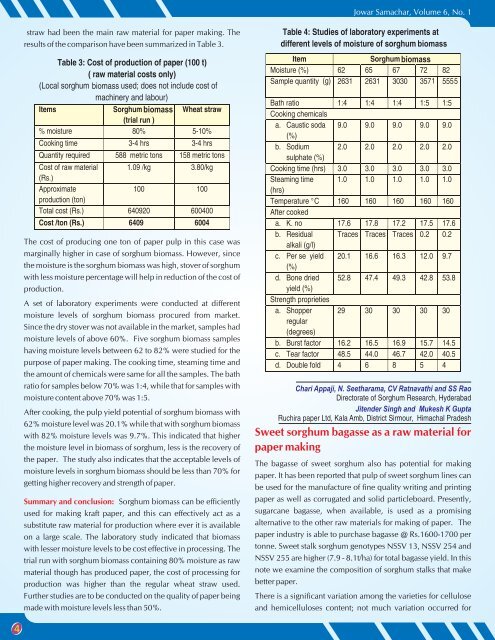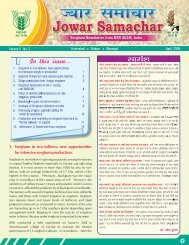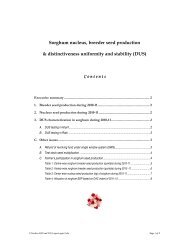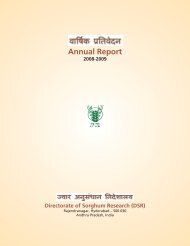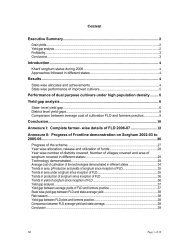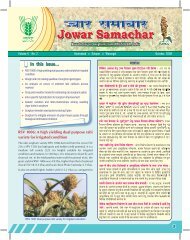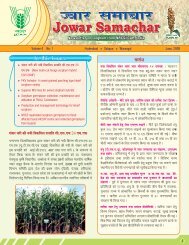jowar samachar feb 2010 - Directorate of Sorghum Research
jowar samachar feb 2010 - Directorate of Sorghum Research
jowar samachar feb 2010 - Directorate of Sorghum Research
Create successful ePaper yourself
Turn your PDF publications into a flip-book with our unique Google optimized e-Paper software.
4<br />
straw had been the main raw material for paper making. The<br />
results <strong>of</strong> the comparison have been summarized in Table 3.<br />
The cost <strong>of</strong> producing one ton <strong>of</strong> paper pulp in this case was<br />
marginally higher in case <strong>of</strong> sorghum biomass. However, since<br />
the moisture is the sorghum biomass was high, stover <strong>of</strong> sorghum<br />
with less moisture percentage will help in reduction <strong>of</strong> the cost <strong>of</strong><br />
production.<br />
biomass<br />
A set <strong>of</strong> laboratory experiments were conducted at different<br />
moisture levels <strong>of</strong> sorghum biomass procured from market.<br />
Since the dry stover was not available in the market, samples had<br />
moisture levels <strong>of</strong> above 60%. Five sorghum biomass samples<br />
having moisture levels between 62 to 82% were studied for the<br />
purpose <strong>of</strong> paper making. The cooking time, steaming time and<br />
the amount <strong>of</strong> chemicals were same for all the samples. The bath<br />
ratio for samples below 70% was 1:4, while that for samples with<br />
moisture content above 70% was 1:5.<br />
biomass<br />
After cooking, the pulp yield potential <strong>of</strong> sorghum biomass with<br />
62% moisture level was 20.1% while that with sorghum biomass<br />
with 82% moisture levels was 9.7%. This indicated that higher<br />
the moisture level in biomass <strong>of</strong> sorghum, less is the recovery <strong>of</strong><br />
the paper. The study also indicates that the acceptable levels <strong>of</strong><br />
moisture levels in sorghum biomass should be less than 70% for<br />
getting higher recovery and strength <strong>of</strong> paper.<br />
Summary and conclusion: <strong>Sorghum</strong> biomass can be efficiently<br />
used for making kraft paper, and this can effectively act as a<br />
substitute raw material for production where ever it is available<br />
on a large scale. The laboratory study indicated that biomass<br />
with lesser moisture levels to be cost effective in processing. The<br />
trial run with sorghum biomass containing 80% moisture as raw<br />
material though has produced paper, the cost <strong>of</strong> processing for<br />
production was higher than the regular wheat straw used.<br />
Further studies are to be conducted on the quality <strong>of</strong> paper being<br />
made with moisture levels less than 50%.<br />
Jowar Samachar, Volume 6, No. 1<br />
Chari Appaji, N. Seetharama, CV Ratnavathi and SS Rao<br />
<strong>Directorate</strong> <strong>of</strong> <strong>Sorghum</strong> <strong>Research</strong>, Hyderabad<br />
Jitender Singh and Mukesh K Gupta<br />
Ruchira paper Ltd, Kala Amb, District Sirmour, Himachal Pradesh<br />
Sweet sorghum bagasse as a raw material for<br />
paper making<br />
The bagasse <strong>of</strong> sweet sorghum also has potential for making<br />
paper. It has been reported that pulp <strong>of</strong> sweet sorghum lines can<br />
be used for the manufacture <strong>of</strong> fine quality writing and printing<br />
paper as well as corrugated and solid particleboard. Presently,<br />
sugarcane bagasse, when available, is used as a promising<br />
alternative to the other raw materials for making <strong>of</strong> paper. The<br />
paper industry is able to purchase bagasse @ Rs.1600-1700 per<br />
tonne. Sweet stalk sorghum genotypes NSSV 13, NSSV 254 and<br />
NSSV 255 are higher (7.9 - 8.1t/ha) for total bagasse yield. In this<br />
note we examine the composition <strong>of</strong> sorghum stalks that make<br />
better paper.<br />
biomass<br />
biomass<br />
There is a significant variation among the varieties for cellulose<br />
and hemicelluloses content; not much variation occurred for


